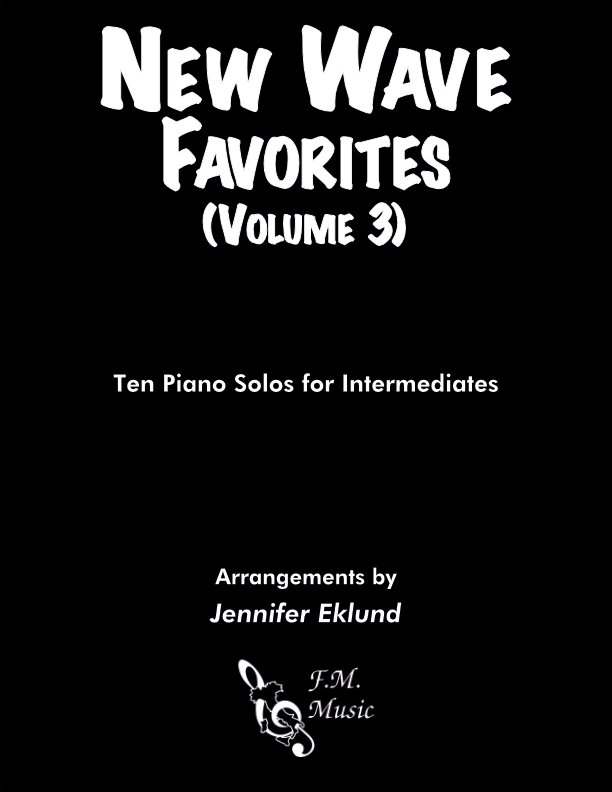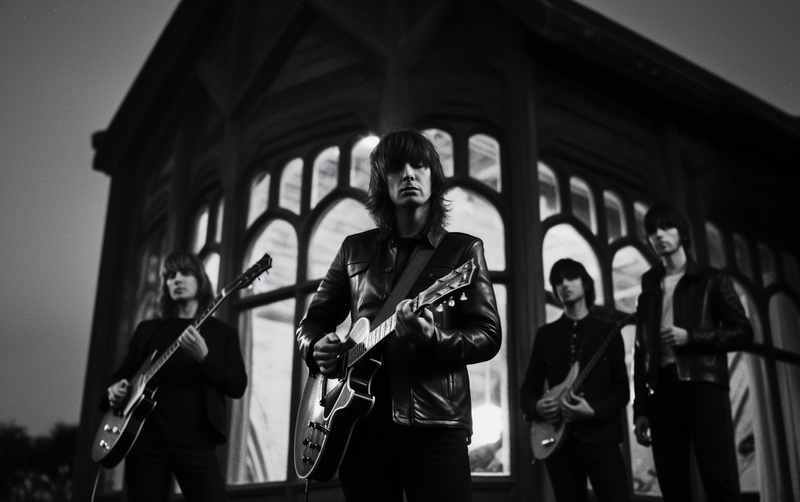🎹 What is New Wave music?
New Wave music spanned the late 1970s through the 1980s and emerged as a more melodic and light-hearted extension of punk culture. It embraced various pop-oriented styles and prominently featured the use of synthesizers. Initially a catch-all term for post-punk musical expressions, New Wave later evolved into a broader umbrella encompassing power pop, synth-pop, alternative dance, and milder forms of punk. It also can be perceived as a more accessible counterpart to post-punk.
Characterized by its distinctive attributes, New Wave music exhibited a playful and humorous pop sensibility, characterized by angular guitar riffs and unconventional rhythms, often enhanced by electronic elements, especially the use of synthesizers. A visually appealing fashion sense and distinctive music videos were crucial to the genre’s success. The movement’s roots lie in Britain, where British New Wave artists initially gained prominence and subsequently captured American audiences through platforms like MTV. The genre is sometimes referred to as the second British invasion.
New Wave’s initial peak occurred from the late 1970s to the early 1980s, supported by major musicians and a proliferation of one-hit wonders. MTV’s launch in 1981 played a pivotal role in amplifying the genre’s popularity by heavily featuring new wave acts. While New Wave experienced a decline in the mid-1980s due to the ascent of other genres, it has resurged intermittently since the 1990s, fueled by nostalgia for its influences. Additionally, new wave’s musical characteristics, including choppy rhythms, quirky pop sensibilities, and electronic incorporation, continue to have a lasting influence on subsequent generations of artists.
🎶 New Wave Favorites: Volume 3 Songbook
The following songs are included in the New Wave Favorites: Volume 3 songbook. These are all available as separate singles, but you get the most value by purchasing the whole collection. All of these arrangements are appropriate for intermediates and up.
- Down Under (Men at Work)
- Hold Me Now (Thompson Twins)
- I Fought the Law (The Clash)
- Love My Way (The Psychedelic Furs)
- Only the Lonely (The Motels)
- Our House (Madness)
- Our Lips Are Sealed (The Go-Go’s)
- Personal Jesus (Depeche Mode)
- The Safety Dance (Men Without Hats)
- Turning Japanese (The Vapors)
🎹 Watch a performance of the entire songbook:
⭐ Featured Favorites
There’s so many great videos from this era that it’s hard to narrow down the best ones, but these personal favorites from New Wave Favorites: Volume 3! made the cut!
“Our House” (Madness) (1982)
It’s in the middle of the street!
“Our House” is a song by the English band Madness, written by Chas Smash and Chris Foreman. Released in 1982 as the lead single from their album “The Rise & Fall,” the song achieved success globally. It reached the top ten in several countries and became Madness’s biggest hit on the Billboard Hot 100. The track won the Best Pop Song award at the 1983 Ivor Novello Awards. In the UK, it peaked at No. 5 on the Singles Chart, while in the US, it reached No. 7 on the Billboard Hot 100 and received substantial radio airplay. The music video depicts the band as a working-class family in various domestic scenes, accompanied by shots of different houses, including notable locations.
“Only the Lonely” (The Motels) (1982)
“Only the Lonely” is a song by The Motels, an American new wave band. It was released in 1982 as the lead single from their album “All Four One.” The song’s music video contributed to its success, debuting at No. 90 on the Billboard Hot 100 in April 1982 and eventually reaching No. 9 in July of the same year, remaining there for four weeks. The track also performed well on the U.S. Cash Box Top 100, peaking at No. 8 for two weeks. The song has a place in the video game “Grand Theft Auto: Vice City Stories.”
Originally, The Motels planned darker songs for their third album but ultimately shelved those tracks except for a reworked version of “Only the Lonely.” Lead singer Martha Davis wrote the song on a guitar given to her by her late father, drawing inspiration from her experiences of both success and personal struggles. The music video, directed by Russell Mulcahy, features Davis as a socialite in a luxurious hotel bar, depicting the contrast between solitude and chaotic excitement. The video won the award for “Best Performance in a Music Video” at the American Music Awards.
“Our Lips Are Sealed” (The Go-Go’s) (1981)
Don’t you just wanna hang out with these girls?
“Our Lips Are Sealed” is a song co-written by Jane Wiedlin, guitarist of the Go-Go’s, and Terry Hall, singer of the Specials and Fun Boy Three. Originally recorded by the Go-Go’s as the opening track on their album “Beauty and the Beat” in 1981, it became their debut American single. The song reached the top 5 in Australia and Canada, and the top 20 in the United States. It features lead vocals by Belinda Carlisle and a bridge sung by co-writer Jane Wiedlin.
In 1983, Fun Boy Three, led by Terry Hall, released their version of the song, which became a top-ten hit in the UK, surpassing the Go-Go’s’ version. The song was praised for its infectious pop qualities, steady dance beat, and catchy keyboard riffs.
The Go-Go’s’ original version received recognition, ranking at No. 57 on Rolling Stone and MTV’s list of 100 Greatest Pop Songs in 2000 and at No. 477 on Rolling Stone’s 500 Greatest Songs of All Time in 2021. The band performed the song at the 2021 Rock and Roll Hall of Fame Induction Ceremony.
The song’s origins are rooted in a brief affair between Jane Wiedlin and Terry Hall during a tour, leading to their collaborative writing. The upbeat music video depicts the band members in carefree scenes around LA, driving a vintage car, visiting a lingerie shop, and splashing in a fountain.
The song’s chart performance includes peaking at No. 20 on the Billboard Hot 100, No. 15 on the Billboard Top Rock Tracks chart, and No. 10 on the dance chart. It maintained its presence on the Billboard charts for an impressive 30 weeks.
“The Safety Dance” (Men Without Hats) (1984)
This video is so ridiculous that I had to include it!
“The Safety Dance” is a song by Canadian new wave/synth-pop band Men Without Hats, initially released in Canada in 1982 as the second single from “Rhythm of Youth.” The song’s inspiration came from lead singer Ivan Doroschuk’s experience of being ejected from a club for pogo dancing. The track gained traction, entering the Canadian top 50 and eventually peaking at number 11. In the US, it reached greater success, spending four weeks at number 3 on the Billboard Hot 100 in 1983, while also topping the Cash Box and Billboard Dance charts. The song achieved international recognition, hitting number 6 in the UK and number 2 in New Zealand, and it was a chart-topper in South Africa. It has been inducted into the Canadian Songwriters Hall of Fame. In 2021, the band released a reimagined version titled “No Friends of Mine.”
“The Safety Dance” is seen as a protest against bouncers preventing pogo dancing in clubs as new wave music gained popularity over disco. The song’s music video, directed by Tim Pope, showcases British folk revival imagery with Morris dancers, Mummers, Punch and Judy, and a maypole. The video’s iconic imagery includes the “S” sign made by the dancers and the involvement of dwarf actor Mike Edmonds. Notably, the song’s meaning has been clarified by Doroschuk, emphasizing that it is not about safe sex or solely an anti-nuclear protest, but rather a broader expression of anti-establishment sentiment.
“Turning Japanese” (The Vapors) (1980)
He’s got a samurai sword and a nifty Polaroid camera!
“Turning Japanese” is a song by the English band The Vapors, featured on their 1980 album “New Clear Days.” The song gained international popularity and became the band’s most recognizable track.
Written by David Fenton, the song’s inspiration stems from themes of youth, angst, and unexpected transformation. It was intended as a love song, with the lyrics depicting a character pining over an ex-girlfriend’s photograph, drawing from Fenton’s personal experience of rejection. The chorus, including the famous line “Turning Japanese, I think I’m turning Japanese,” came to Fenton suddenly at 4am and was incorporated into the song despite not holding deep meaning.
Produced by Vic Coppersmith-Heaven, the song’s arrangement underwent changes during recording. Coppersmith-Heaven captured the band’s live energy in the recording, eventually overdubbing to finalize the track. The band believed “Turning Japanese” would become a hit, deliberately delaying its release to avoid being labeled as one-hit wonders, even though they never replicated the song’s success. The single achieved No. 1 status in Australia and experienced minor success in Japan. The music video, directed by Russell Mulcahy, adds to the song’s popularity.



 - Easy/images/Cover--ourhouse-EZ-MN.png)
 - Intermediate/images/Cover--ourhouse-INT-MN.png)
 - Easy/images/Cover--onlythelonely-EZ-MN.png)
 - Intermediate/images/Cover--onlythelonely-INT-MN.png)
 - Easy/images/Cover--lips-EZ-MN.png)
 - Intermediate/images/Cover--lips-INT-MN.png)
 - Easy/images/Cover--safety-EZ-MN.png)
 - Intermediate/images/Cover--safety-INT-MN.png)
 - Advanced/images/Cover--safety-ADV-MN.png)
 - Easy/images/Cover--japanese-EZ-MN.png)
 - Intermediate/images/Cover--japanese-INT-MN.png)
 - Intermediate/images/Cover--head-INT-MN.png)
 - Intermediate Full/images/Cover--lips-INT-FULL.png)
 - Advanced/images/Cover--themetro-ADV-MN.png)
 - Easy/images/Cover--inbetweendays-EZ.png)
 - Easy/images/Cover--veronica-EZ-MN.png)
 - Intermediate/images/Cover--bizarrelovetriangle-INT-MN.png)




Be the first to comment.